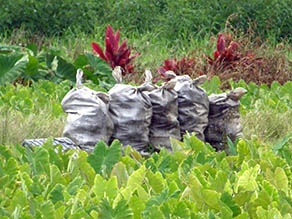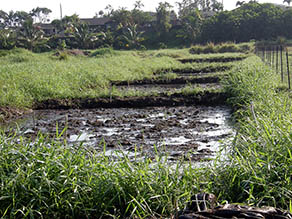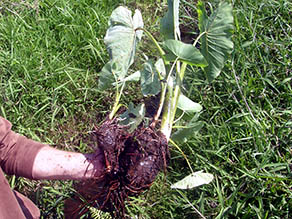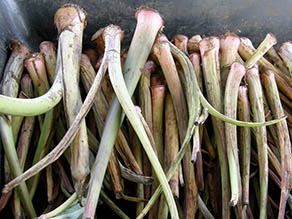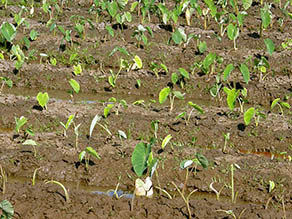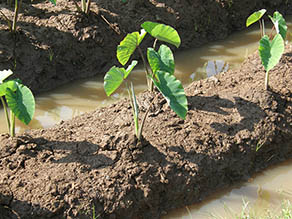 |
 |
 |
 |
||||||
|
|
|
|
|
|
|
|
|
|
 |
|
 |
|||||||
 |

Part of the taro lo‘i system at Hoi. “This was all lo‘i, everywhere was all lo‘i,” Alice says, refering to wet-taro pond fields. “Up to Ha‘ikū road it was all lo‘i, up Ha‘ikū Road, He‘eia Road, Kāne‘ohe Drive, every spare land had lo‘i. Everybody that had a property had a lo‘i and chicken farm or pig farm or something like that. Nobody starved and everybody had something to do. “There was taro across King School. There’s taro on the bottom and we had our own taro-making place and right across King School. It’s still there but it became a house. We had one of the second I think, second or the third taro poi mill. They steamed the taro, they did everything there, but they bring the taro from there that down the bottom. So we used to go over there and I wasn’t too much in that muddy water.” “There were so many vegetable gardens, flowers, all the way up to Ha‘ikū where we live. Our house is across Ha‘ikū, Haleiwa Joe’s. We have three houses there. It used to be all gardens—vegetables, flowers—and that was taking care by the Japanese, not Hawaiians. Hawaiians was the taro, and the Japanese was the vegetables. “My father, Hoi was part of their property,” Rocky recalls. “They had owned it, they mālama’d it. My father always told me before they came go to school to St. Ann’s, they’re all had to get up early, and they got to have at least one gunny sack, those big potato sacks, full of kalo to get it ready for my other uncle to put it through the factory to make poi. My father is one of twenty-one children. One of his aunts he said, she challenged them, and she carried two. “He said, ‘You try carrying one.’ I can’t even carry one bag right now, but to carry that? That was hard work. And the guy had to do it before they went to school. That was always referred to as Hoe. My uncle had this poi mill in Hoe. There was two poi mills in Hoe. One on the road. There’s also ruins of one up on the hillside, right smack in the middle.” “Growing taro is very much a cyclical process,” says Nick Reppun. “It’s sort of like a never-ending process. When my dad and his brothers started farming, they were asking taro farmers at the time, the old-timers, getting tips on what to do. And people gave them huli to start planting. They say that they planted their first batch, and then part of the cyclical nature, they say that 30 to 40 years later, all of a sudden, oh, here they still are doing the same thing; kind of just got caught up in the cycle of it. “In terms of the life cycle of the plant, you have to prepare your field for planting. The details of that kind of vary depending on the piece of land that you’re growing on, whether you’re growing dryland or wetland. But basically, you’re taking a fallow field and either tilling it, or mixing in any organic matter through whatever means possible—whether it’s mechanical or getting a group of kids to stomp it all into the mud. “That was traditionally how it was done with a large group of people, and you just use your feet to smash things into the mud and prepare the land that way. But first remove the old organic matter, add any fertilizer that you’re going to add. And once the fertilizer has some time to sit and start breaking down, you can then plant your huli. And the huli are cuttings that have been taken from the previous generation. Learn more about huli, the cuttings that produce taro plants “Hopefully, in your cycle, you’re always planting and always harvesting, so you can take your cuttings from whichever lo‘i that you’re currently harvesting. You save cuttings from the babies. Then you plant the huli and that one huli will grow. Early on, it puts all of its energy into leaf growth and true roots. At a certain point, it switches and pours its energy into the development of the corm, which is a part that is most commonly eaten. “It gets really big in its leaf-growth stage, and then on a certain point, the leaves start shrinking down and you’ll notice it visually, you’ll see the leaves start to shrink, and that’s when you know the taro is starting to mature. It’s pouring all of its energy into the corm development. At some point during the leaf growth phase, it’ll start producing little babies, little ‘oha that come off of the side. “The original huli that you plant is what they call the makua. That’s the same interesting thing about taro, is it grows in these family groups and the same words are used to describe the taro family as are used to describe the human family. So you have the makua, which is the parent plant; you have the ‘oha, those are the children. And so, when you save huli, you usually save the ‘oha. They’re younger, they’re usually more productive. If you have to save makua, you can. But most people will say that after so many times of saving the makua, it starts to get a little weak and doesn’t perform as well. “You could plant the entire ‘oha, but you want to eat the corm, usually. That’s the goal: you’re getting as much as you can. I have done before where if you’re short on huli, you can take the corm itself and put that in a pot, or put in the ground, and the corm itself will sprout more. When we’re lucky enough to collect varieties from other people to build up our variety collection, they may only let us take one ‘ohana, and I’ve only got four or five, maybe six huli from that. “You cut the corm right to the point where you see the meristem,” Kanekoa says. “You put it in the ground and you have it above the breathing hole, and it’ll grow up from here. Maybe about five inches deep, depending on the size of the huli. If the huli is larger, you can plant it deeper. You want to cut it right above this and keep it above this breathing hole.” “But then after I cut the huli,” Nick continues, “I can take the small corms, put those in a pot, and those will sprout. Each corm may sprout another five or six, and then you let those grow for a little while, and then you dig it up, and then you recut the huli, and then you plant. “In a commercial sense, there’s an advantage to cutting the huli. If you were to plant the corms, eventually it’ll sprout, but then what’s left in there is going to rot too. You could potentially introduce disease or pathogens that may have been in the field that you got it from. It’s partly a way to sort of clean your seed, so to speak, as you cut the huli. “Usually, you let the huli dry out for a day or two to seal off that cut portion. That way pathogens don’t have an easy in to the plant as soon as you put it in the ground. But there’s all different ways. If you need to get more huli, then you cut a makua—a big makua—into a bunch of pieces and plant those, kind of like how people plant potatoes. “When the leaves are shrinking down, that’s one way that keys you in that the taro is ready for harvest. Different varieties mature at different rates, and then there’s also a difference in the same variety, whether you grow at wetland or dryland. And really, to know precisely when to harvest it takes time, and experience, and observation.” “Depending on the taro variety and the temperature of the water and the soil,” Kanekoa adds, “it could be from 9 months to 14. You’ve got to take care of it of course—weeding, fertilizing at different times (with hopefully organic systems), making sure there’s a discussion between the water, and warm water, cold water, aerated water, anoxic water. “What I always do,” Nick says, “is I know approximately how many months it takes a given variety to mature, and when it’s close to that timeframe, I just go in the patch, pull some samples from all different parts of the patch—the corner, the middle, all over the place—cook it and eat it and see what it’s like. “You can look at the way that the starch grain, the way the starch is formed in the taro. You can see it when it’s raw, when you cut it. So you might cut it in half lengthwise, and you can see certain characteristics in the grain of it. It’s almost like a wood grain, when you look at a wood grain and tell things about it. “But then when you cook it, you’ll know—again through experience—what the desired qualities are. A lot of it is time and observation and experience, or you learn from somebody who has that knowledge already. But, you can just pull some, test it... A lot of people like to hand-pound it into poi, and that’ll also indicate quality of the taro as well—how dense it is, how starchy it is. Because at a certain point, the starch in the corm will start breaking down from complex carbohydrates into simple carbohydrates, and then sugars, and where it is in that transition affects the quality, which is primarily significant when you’re looking at developing value-added products like poi. Your overall yield from, say, 100 pounds of raw taro, if it’s really starchy, you might be able to get 100 pounds of poi. If it’s not very starchy, you’re not going to get that much.” Nick Reppun talks about the ‘ulu trees at Hoe All taro can be grown in dry land, but not all taro can be grown on wetland, is what we were taught. “We’ve been pretty darn successful in growing a taro,” Kanekoa says. “Those patches there were producing like eight-pound to seven-pound corm, so we’re pretty happy with it. And we want the families to do it. That patch next to it is actually a group of five families that have farmed that taro. So we’re just getting them back on the land and getting them to start to ‘āina momona a lot more, we hope. “We have 20, probably 30 varieties right inside there. That’s ‘Uahi a Pele, and as you go further down, you’ll see Pi‘i, which is a more plaited taro. You go left, there are different colors of petioles. They wanted to plant multiple varieties of taro along the side, and it’s all labeled. Again, we just wanted to see which varieties do very well in our property, and then we’re going to start procreating it. So you’ll see ‘Uahi a Pele in one patch, you’ll see Manini Ke‘oke‘o, Manini ‘Ula‘ula. You’ll see Ka‘ī. You’ll see just a lot of different varieties growing out into the system. So that when the families are farming, they said, ‘Can we have one patch, one row of Manini?’ I say, ‘Here you go.’ “Unfortunately, I’m sure there are a lot of varieties that disappeared. Papahana is really the one that can hold the varieties, because they are an actual nursery. We want to at least start growing some of our own and seeing how they react as climate occurs and how things change.”
|
 |
|
 |
Planting is not the only method by which sustenance is derived from the land. Gathering of various sorts from the forests also provides important food sources.
|
 |
||
 |
|
 |
||

|
 |
||||
|
||||
Copyright 2019 Pacific Worlds & Associates • Usage Policy • Webmaster |
||||
